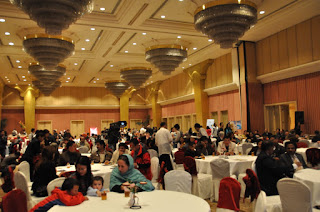Community Radio : The Voice of the People
 |
The sun illuminates the green patches of cauliflowers and cabbages in the field as farmers arrange sacks of crops to be dispatched to the city. Karuna Bista sports her Kurtha Suruwal, arms herself with a cassette recorder, and prepares to take the first story for the day. Broadcasting within a 60-kilometer radius, Radio Palung is perched up in the hill south of Nepal, and Karuna’s voice is heard by 2,000 households, reaching as far as Bihar, India.
Karuna is one of the 9 reporters in Radio Palung, a community radio that is 3-hour drive from Kathmandu city. The station prides itself of installing the first audio tower in Asia, with distinct amplifiers that generate the voice news in 3 languages - Tamang, Newari and Nepali. Karuna captures narrative snippets of farmer’s activities, recording their daily experiences on vegetable diseases, and consulting experts on how to resolve it. Informally, farmers share their views on site, and this is broadcasted to listeners using satellite technology.
This kind of community radio empowers the whole village to build their capacity for problem solving, decision making, and collective action. It also replaces the function of the telephone systems wherein messages can be broadcasted advising that a relative in another village is ill, announcement of parents-teachers meeting or placing a public notice that a goat or buffalo is up for sale. Remarkably, advertisements such as these maintain the radio’s 70 percent operational expenses, the rest of which comes from donations and grants.
Community radio has established its position across Asia since 1980’s. In Sri Lanka, a shining impact of this unique technology enabled the movement of a million of settlers from lush upstream habitations to arid zones, when Mahaweli River Development Authority constructed a massive dam in 1980. Mahaweli Community Radio used 7 jeeps, 40 radio producers and technicians, and followed the settlers in major zones of the Mahaweli region before the actual release of water dams.
This was soon followed by the Philippines with Tambuli Community Radio. Tambuli stations are known to cultivate social consciousness of the community. In Camarines Sur, the Goa Station convinced its listeners to give up gambling, something that the law enforcement had not achieved. In Thailand. community radio is credited for having mobilized the peasants and farmers' red shirt movement to bring down the traditional ruling elites in Bangkok that include the monarchy and the military.
Nepal, whose inspiration was Tambuli, has seen a dramatic increase in community based radio within the Himalayan republic. Today, there are over 60 community radio stations operating in the country, using low powered transmitters and independent of government and commercial interests. Raghu Mainali, who has been in the forefront of community radios in Nepal, admitted that acquiring the license for Radio Sagarmatha was a test of time. After 6 years of continuous saga, Radio Sagamartha became the first independent community radio in the entire South Asia. Now, it is empowering voices of 2.5 million regular listeners.
Radio Sagamartha has always ensured a community oriented voice. To demystify the technology, Raghu’s team brought a mobile radio, 12 kg. in weight, and demonstrated its effectiveness by broadcasting in front of the people. This started championing people’s voices. This is the same medium that mobilized the people in a democratic movement to overthrow the monarchy and created a republic in 2006.
Nepal’s experience with community radio is renowned for approaches of ingenuity and innovation. Unique protests like blowing conch shells in air time signified death of a political stance, playing the same kind of music in all stations served as satirical complaints, and singing broken parts of the Constitution to the people all hammered the government to perform what they are elected for. This has effectively converted movements into joint protests and created mass rallies for peace and solidarity.
In December 2005, Radio Sagamartha was raided by army troops and the journalists were arrested. The crackdown was initiated by the royal regime against the radio station for broadcasting an interview from CPN-Maoist that was transmitted from BBC Nepal Service. During that time, community radio stations used to broadcast content produced by radio production units from the centre of Kathmandu. Now, media pluralism can be heard from radio messages that are delivered with dialogue, music, and words in more than 50 languages that are easily understandable to the people who can’t read or write. Stories are owned by the community and villagers can now speak about their everyday affairs with greater assertion.
The presence of community radios in Nepal has given voice to 85 percent of the country that is known for its mountainous geography. This has opened a media to discuss issues in their own dialect. Community radios continuously beams across Asia as it significantly changes the lives of the people.



Comments
Post a Comment